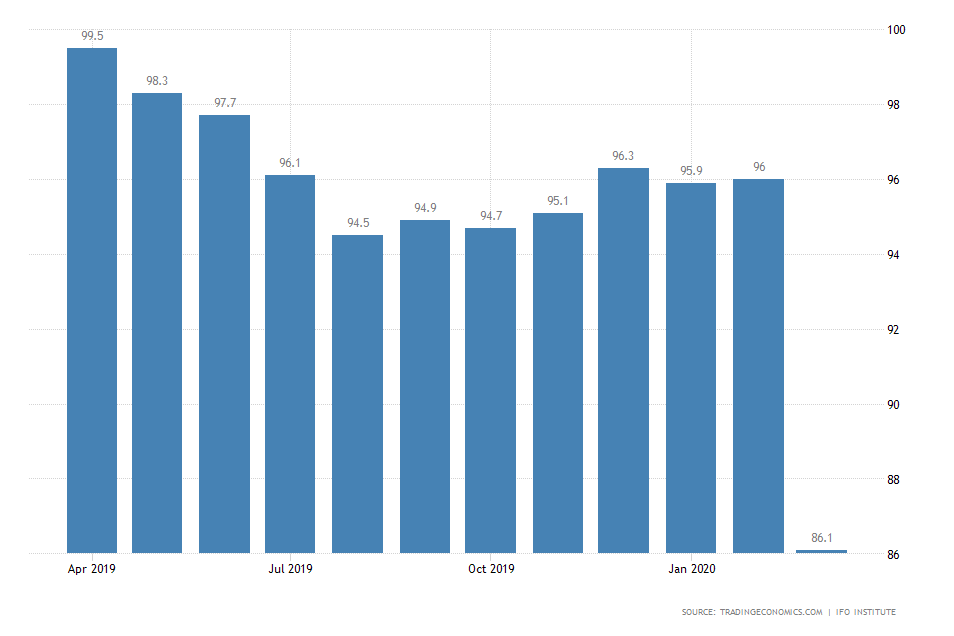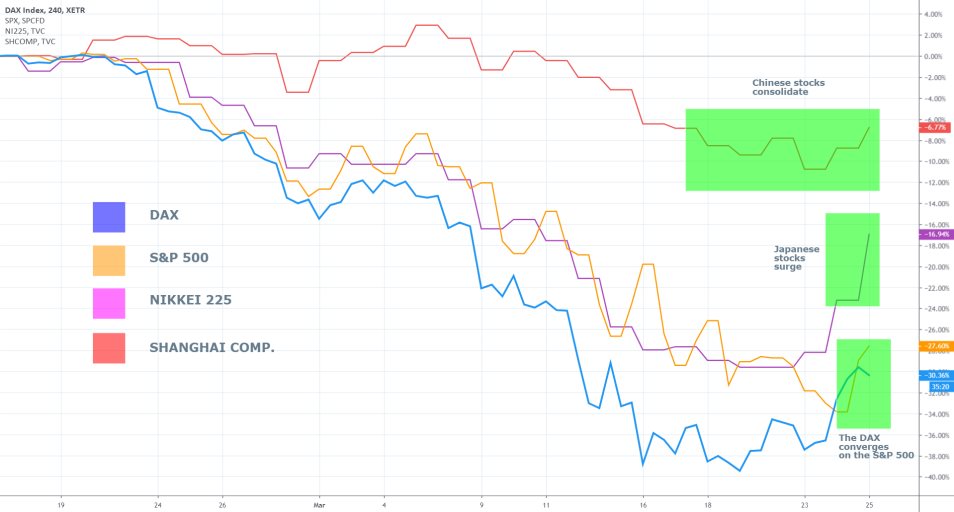The German government will be gathering today to vote on a historic proposal for unprecedented in size relief package for the reeling German economy.
The vote in the Reichstag is anticipated to ease off some of the strain that is currently weighing down on the biggest economy in the Eurozone.
According to Bloomberg, the size of the relief package is going to reach 156 billion euros, which is equaling 4.5 per cent of the country’s Gross Domestic Product. The bailout package is going to be added to the 600 billion-euro of the active rescue fund.
The historic expanse of government spending is expected to be agreed on just hours after the release of the IFO business climate report for Germany.
According to the IFO institute, the index has tumbled to 86.1 points in March from the 96.1 points that were recorded in February. The findings of the report missed the consensus forecasts, which were projecting a smaller reduction of the index to 87.9 points.
Thereby, the business climate in Germany has fallen to its gloomiest outlook since July 2009, which was in the wake of the recovery process from the 2008 credit crunch.

The German DAX index has tanked by 1.08 per cent today since the data release. The plunge wiped out some of the gains from yesterday’s jump, which recorded the remarkable 10.98 per cent daily gains.
The fall, however, is likely to be stopped by the end of the trading day, as the announcement of the increased government relief package is expected to reinvigorate investors’ confidence in the short run.
Additionally, it should also be acknowledged that the consensus forecasts for IFO's business climate index were compiled without acknowledging the likely impact of the coronavirus fallout. It is therefore not so surprising that the reported data missed the forecasts.
Nevertheless, the market has already started pricing in the real impact of the national lockdown in Germany, following the release of yesterday’s Services and Manufacturing PMI data.
That is why the DAX, which has generated the biggest losses in the aftermath of the pandemic compared to the other three indices on the chart below, managed to converge on the S&P 500 yesterday. Meanwhile, the economies in East Asia are already showing early signs of recovery from the initial slump.

Trendsharks Premium
Gold is undergoing a correction, as investors take profits to offset losses from falling stock prices, impacting their margins. However, we anticipate a renewed wave of [...]
The Swiss stock market index is mirroring its global counterparts, such as Germany 40 and US100, experiencing a sharp decline following the announcement of new [...]
We’re analyzing the weekly chart to grasp the broader market trend. Over the past three years, the US30 index has surged by 17,000 points, often resembling a nearly straight [...]
Over the past week, the DAX has experienced a sharp decline, plunging by an astonishing 3,400 points. This downward movement is not isolated, as its international counterparts, such as the UK100 and US100, are also facing significant [...]
EURUSD recently formed a double top at 1.0930, signaling a potential trend reversal, and has since begun a correction. After a 600-pip rally since early March, a pullback at this stage is both expected and healthy. Given these conditions, we are placing a [...]
Since early March, EURJPY has surged nearly 1,000 pips, providing us with several excellent trading opportunities. However, as the rally matures, many early buyers are beginning to take profits, leading to a noticeable slowdown in the uptrend. On Friday, the pair formed a [...]
The AUDJPY currency pair continues to be dominated by bullish momentum, as multiple golden cross patterns reaffirm the strength of the ongoing uptrend. Despite this, we are witnessing a much-needed [...]
The EURAUD currency pair appears to be undergoing a trend reversal, signaling a potential shift in market direction. A notable technical development is the formation of a Death Cross on the chart, a widely recognized bearish indicator that typically suggests a [...]
After securing an impressive 200-pip profit last week, the EURJPY currency pair is now undergoing a southward correction, retracing some of its recent gains. Despite this temporary pullback, the Golden Cross remains intact, reinforcing our view that the overall trend continues to be [...]
The appearance of a Golden Cross in Silver strengthens our analysis that the metal is currently in a strong uptrend, indicating further bullish momentum in the market. This technical pattern, where the short-term moving average crosses above the [...]
This trade presents a considerable level of risk and can be classified as an opportunistic move based on recent price action. The GBPUSD currency pair has experienced a substantial bullish rally, surging by nearly 500 pips in a strong upward movement. However, after this extended period of appreciation, the pair is showing signs of a potential [...]
The anticipated Death Cross on the SMI20 appears to be failing as price finds strong support at the 23% Fibonacci retracement level. After testing this area, the index has shown bullish strength, printing several large green candles, signaling an increase in [...]
A Golden Cross has just appeared on the USDJPY chart, signaling a potential bullish move. This technical pattern occurs when the 20 period moving average crosses above the 60 period moving average, a widely recognized indication of increasing [...]
After 2 months of a down trend, we finally see some indications of price recovery for Oil. The golden cross, a historic buy signal, supports this [...]
For the past month, the German DAX40 has experienced a remarkable 10% surge, reflecting strong bullish momentum. Despite ongoing market volatility and frequent pullbacks, every dip continues to attract fresh buyers, reinforcing the [...]
Oil continues its downward trajectory, despite occasional pullbacks. The overall trend remains bearish, reinforced by multiple Death Cross patterns, a classic sell signal indicating further weakness. Adding to this bearish outlook, the critical [...]
Over the past few days, gold has experienced a sharp decline of more than $100. This downturn can be attributed in part to traders securing profits to manage their margins, which are under strain due to the significant drop in major indices. Currently, gold has fallen below the [...]
The NASDAQ 100 index is showing strong bullish momentum, as evidenced by the formation of a Golden Cross on the chart. This classic buy signal occurs when the short moving average crosses above the long term moving average, suggesting that upward momentum is [...]
The EURAUD currency pair has encountered a significant resistance level, failing to break above the critical 61% Fibonacci retracement level. This suggests that bullish momentum is weakening, reinforcing the case for a potential downward move. Given this technical setup, we favor entering a [...]
The UK100 is experiencing a remarkable rally! Over the past few weeks, the British stock market index has surged nearly 800 points. Each minor dip has attracted more buyers, fueling the bullish momentum. However, since last week, we’ve observed a slight [...]




















